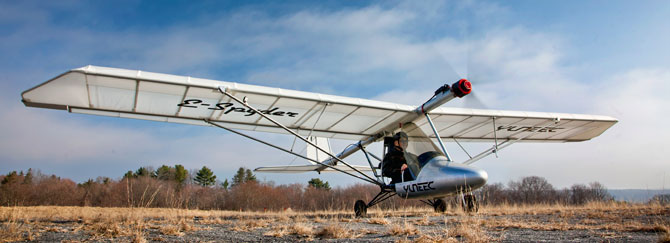Photography by Chris Rose
Electrically powered light airplanes have caught the imagination. Comparatively inexpensive to operate and emission-free, a new crop of electric designs have moved into the spotlight. Are they ready to go to market? Are they too flimsy to attract a meaningful customer base? How do their power and propulsion systems operate? Can they provide true utility? Are they the beginning of a groundswell? And what are they like to fly? Those are the questions we’ll answer in the following articles.
•••
The pressure to reduce our dependency on fossil fuels is quickly becoming a dominant economic, environmental, political, and technical force that we’ll all have to deal with—and soon. Most of us have become aware of this because of the way the automobile industry is handling these issues. The 1975 Corporate Average Fuel Economy (CAFE) regulations, for example, were recently changed. They order that passenger cars must double their fuel efficiency to a fleet average of 54 mpg by 2025. In response, car manufacturers are turning to electric power, and drivers are discovering both the advantages and disadvantages of relying solely on batteries.
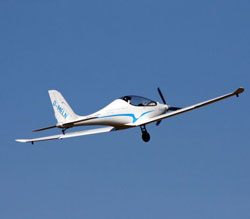 PC Aero Elektra One
PC Aero Elektra One
But what are the issues affecting the use of electric power in small general aviation aircraft? Once again, battery technology and performance are at the heart of the matter. Here’s where a quick overview is in order.
We’re all familiar with the lead-acid battery, which has been around for more than a century. They use lead plates submerged in an acid electrolyte to generate power, and have positive and negative electrodes. They’re great for producing short bursts at high output, so they’re perfect for starting engines. All that lead makes them heavy, the electrolyte is corrosive, and their self-discharge rates aren’t anything to write home about. Depending on the age and condition of a lead-acid battery, it can discharge up to 20 percent of its capacity per month. High electrical draws coupled with failure to keep these batteries properly charged will cause lead sulfates to fall from the plates; they eventually build up until the battery slowly dies, shorts out, or cracks. Lead-acid batteries may put out plenty of power—but only for a short time before needing to be recharged.
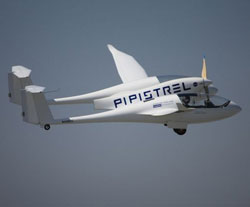 Pipistrel Taurus G4
Pipistrel Taurus G4
With an energy density (the amount of energy produced per unit of weight) of about 11 watts per pound, there’s no way lead-acid batteries can compete with gasoline. At an energy density of about 5,500 watts per pound, gasoline remains the gold standard for packing a punch. To have the same amount of energy as a pound of gasoline, an airplane would have to carry about 220 pounds of lead-acid batteries! Put another way, to get the energy of 10 gallons of avgas, you’d need some 14,500 pounds worth of lead-acid batteries. So the lead-acid battery—and its cousin, the nickel-cadmium battery—are definitely not the wave of the future for airplane propulsion.
Enter the latest methods of storing electrical power: the lithium-ion and lithium-ion polymer (sometimes abbreviated LiPo or LiPoly) battery. These batteries put out less electrical power, but they last longer and weigh very little when compared to lead-acid batteries. The lithium-ion battery has a gel electrolyte and a metal outer case. The LiPo uses layers of a polymerized composite material to hold the lithium-salt electrolyte, has a small amount of gel electrolyte, and is enclosed by a polymer-laminate case that can be molded into various shapes. Because they’re so light and easy to shape, lithium batteries found a huge niche in the cellphone and other consumer electronics markets beginning in the 1990s. The LiPo design is the most recent development, but both have great energy-density characteristics—with weight-to-power advantages over lead-acid batteries approaching 1,400 percent. Other advantages include low self-discharge rates and no maintenance requirements.
 Yuneec e430
Yuneec e430
But there are some downsides. Lithium batteries can overheat while charging and discharging. Even worse, lithium is flammable when exposed to air, making a damaged or leaking case a potentially dangerous situation. That’s why electrically powered aircraft have electronic control units to protect against overcharging, manage battery condition, and monitor the charge balance between cells. Even so, the safety of lithium batteries is improving. When a lithium battery runs away, it doesn’t explode; it simply gets hot and may eventually burn. To guard against this possibility, manufacturers such as Yuneec and others enclose their batteries in fireproof boxes and isolate them with fuses. But let’s not get too cheery about lithium battery safety just yet. A spate of lithium fires in hybrid automobiles proves that what can go wrong, will.
Battery control units also display system voltage and amperage, so that the pilot can keep track of the “fuel quantity” (voltage) both before and during flight.
Lithium battery technology has come a long way, but the truth is the batteries used in today’s electrically powered aircraft don’t last very long, still weigh a lot (the Yuneec e430’s battery weighs 184 pounds), and have minimal power output. Nominal run times rarely exceed two to three hours, which is fine for local flying, but hardly enough to make electric airplanes viable cross-country machines.
 Pipistrel Taurus Electro
Pipistrel Taurus Electro
However, electric airplanes are benefitting from advances in battery technology in the hybrid automotive and cellphone industries. Some feel that lithium-ion battery endurance will soon increase by a third, making possible longer flights at higher power settings. Even so, battery endurance depends heavily on pilot technique and local weather conditions. Today’s battery-powered airplanes, such as Pipistrel’s Taurus Electro G2, yield optimal battery endurance when power is reserved for takeoffs and climbs. Once at altitude, the idea is to shut the engine down, conserve battery power, and soar as long as feasible before once more drawing on battery power. The G2 is essentially a two-place sailplane with a retractable electric engine and retractable landing gear.
Recharging is another area that’s seeing a lot of attention. In keeping with eco-friendly philosophies, solar-powered charging stations seem to be taking root. Pipistrel’s Taurus G2, for example, has what the company calls its Solar Trailer. When the airplane is stored in the trailer, solar cells charge the airplane’s batteries—a process that takes about five hours. Other companies mount solar cells on hangar roofs, then route their electrical lines and charging circuits to outlets inside. The Solar Impulse—a four-engine design that flew for 26 hours on battery power (and through the night)—uses wing-mounted solar cells to constantly charge its onboard batteries. Or there’s the old standby: plugging a specialized charging unit into a wall socket. Using this method, most lithium-ion batteries will recharge in three hours or so.
To an overwhelming degree, the key to electric aviation’s progress toward public acceptance and market success depends on big improvements in the battery department. They need to become lighter, more powerful, longer-lasting, and quicker to recharge. Perhaps when Apple makes the iPhone’s battery reliably yield a full day’s worth of use, the secret will move electric airplanes to the next level.
Spyderflight
Back in the early 1980s, all the general aviation magazine writers (including me) covered ultralights, which were viewed as vehicles for recruiting new pilots, with the goal of boosting recreational flying and providing an entry point for neophytes to graduate to the ranks of conventional general aviation. Well, that didn’t happen. But now, a new lightplane movement is afoot—one propelled by battery power and electric motors—and I felt the call of duty once again. After all, maybe an age of electrically powered general aviation is dawning.
Tom Peghiny
In addition to being president of Flight Design-U.S., Peghiny is the chairman of the airplane subcommittee for the ASTM (American Society for Testing and Materials) rulemaking body that develops today’s LSA certification standards. He’s also on the board of directors of LAMA (Light Aircraft Manufacturers Association) and a consultant for BRS (Ballistic Recovery Systems—a manufacturer of airframe-mounted emergency parachutes). In 1997 Peghiny received a meritorious service award from the USUA (United States Ultralight Association).
Chinese manufacturer Yuneec contracted with Peghiny to build the E-Spyder prototype as part of that company’s effort to develop a line of electrically powered lightplanes. Yuneec hasn’t yet revealed whether it plans to sell the E-Spyder—or the e430, its electric two-seater—but the die is cast. —TAH
The electric-airplane phenomenon may have its origins in Europe, where user fees, high gas prices, and heightened ecological sensitivities have always combined to prod designers into making ingenious lightweight aircraft. But there’s a smattering of electric airplane prototypes in the United States, and I found one at Light Sport Aircraft manufacturer Flight Design’s U.S. headquarters at the South Woodstock Airport, in northeast Connecticut. It’s called the E-Spyder.
The airplane has an empty weight of 190 pounds, a 27-horsepower motor, and cruise speeds around 30 to 40 knots, so I had an idea of what I was in for—ultralight flying. Its 33-foot wingspan and light weight meant light wing loadings and a sensitivity to gusts, updrafts, and downdrafts that I hadn’t experienced in a long, long time. And the E-Spyder’s single seat meant something else: No dual instruction. Tom Peghiny, president of Flight Design USA and the creator of the E-Spyder, would be my instructor—basically, he’d give me a good talking-to before I launched. Then I’d be on my own.
It’s the electric motor that first grabs your attention. It’s about the size and shape of a big coffee can, and it sprouts a three-blade, carbon-fiber propeller built by Helix Carbon GmbH of Germany. The prop diameter is a whopping 70 inches, and the prop blades look like stylized swords. The motor, motor controller, battery pack, throttle control, and instrument cluster are built by Shanghai-based Yuneec International, a company that’s working on what promises to someday be a fleet of electrically powered GA aircraft—one of them being the E-Spyder, which was bought from Peghiny.
The motor drive system consists of a lithium polymer battery enclosed in a protective metal case and a motor controller. The throttle sends signals to the controller, the controller tells the motor how fast to turn, and that’s basically it for the propulsion system. Simple. Oh, and there’s an airspeed indicator and altimeter.
An instrument cluster lets the pilot watch the power output, voltage, propeller rpm, and the battery and motor temperatures. Hot is bad because of the lithium, and low voltage is equally bad—because when the volts head below 60 you’re running short on “fuel.” A fully charged battery has 77.6 volts’ worth of juice.
 Display views can be called up on the motor management system’s screen. The gauges show battery and motor temperatures, propeller rpm, power output, and voltage levels—the latter being a sort of “fuel gauge” showing remaining current levels.
Display views can be called up on the motor management system’s screen. The gauges show battery and motor temperatures, propeller rpm, power output, and voltage levels—the latter being a sort of “fuel gauge” showing remaining current levels.
The airframe is based on Peghiny’s original Flightstar ultralight, which means an aluminum tube structure with a wingspan some three feet longer than the Flightstar, and sheared wing tips for drag reduction. There’s a ballistic parachute system in case the worst happens and full-span ailerons for roll control. The flight controls are actuated via heavy-duty Teleflex cables.
For a piston driver, the procedures, sounds, and throttle response of the E-Spyder power system take some getting used to. First, the motor and propeller are silent and motionless—until the moment you advance the throttle. Then the prop springs to life instantly. There is no warm-up time, no magneto checks, no propeller cycling, no valves to burn, no cylinders to crack, and no fuel boost pumps to monkey with. It’s like turning on a light switch. TBO is 2,000 hours, and overhauling the motor takes about two hours. You remove and replace two bearings, its only moving parts.
What does the motor sound like? Some say it’s like a Dremel tool, only at a lower rpm. Others compare it to an electric shaver, or even a washing machine in the spin cycle. I think it sounds a lot like an electric lawn mower, only quieter.
To conserve battery power you push the airplane to the runway (easy, because it’s so light), then get in. And there I am. Bicycle helmet on my cranium, butt in a sling (well, not really, but it seemed that way), feet on the rudder pedals, and asking for ear plugs. I’m thinking of ultralights, many of which put a screamingly noisy 50-horsepower engine right above your head. “You won’t need ’em,” Peghiny says.
OK, here are the numbers: full throttle for takeoff, rotate at 30 mph, climb out at 45 mph, cruise at 40 mph, and fly approaches at 45 mph. I do as I’m told and within maybe 100 feet of ground run I’m airborne at 45 mph. And going up like a runaway elevator.
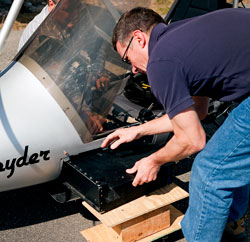 The E-Spyder’s 76-pound battery case slides out of its location under the floorboards for charging. Plug it into a 220-volt socket and after two to three hours of charging, you’re ready to fly. Flight endurance depends heavily on power setting. Use 2,000 rpm for initial takeoff power, then 1,600 rpm for a normal climb. Pull the throttle control all the way back, and the propeller stops—right now!
The E-Spyder’s 76-pound battery case slides out of its location under the floorboards for charging. Plug it into a 220-volt socket and after two to three hours of charging, you’re ready to fly. Flight endurance depends heavily on power setting. Use 2,000 rpm for initial takeoff power, then 1,600 rpm for a normal climb. Pull the throttle control all the way back, and the propeller stops—right now!
Is it really all that quiet? Answer: Yes. The sound you hear is the chuff-chuff-chuffing sound of the propeller and maybe some wind noise, well blanketed by the windshield. Level at 500 feet I power back to 1,600 rpm and let the speed bleed back to 35 mph or so. Somewhere on the ground I hear a car door slam, and was that a bird I hear? No, you don’t need ear plugs.
My only issue with the E-Spyder is those huge ailerons. In turns they create huge amounts of adverse yaw, so it takes a while to learn the correct amount of rudder to compensate for it. In turbulence, the E-Spyder acts like an ultralight, getting bounced around and yawing and rolling. In calm air the ride is smooth and quiet. It’s gobs better than the teeth-rattling, vibration-permeated ride you’d get in an ultralight.
Soon I’m coming down final for an acceptable landing, if I do say so myself. I flare a foot or so above the runway—much lower than a typical piston driver would. As I pulled back to idle, there’s another quirk: The propeller stops. Power off means just that. For kicks, Peghiny slows to 30 mph in cruise, cuts the power, and raises the nose slightly to stop the propeller. Now it’s time for soaring in thermals, or just gliding. Want to turn the power back on? Just advance the throttle.
Is the E-Spyder the leading edge of the wave of the future? That depends on how, or whether, Yuneec plans to market it. For now, it’s a valuable testbed that proves electrical power can efficiently power a GA airplane. Its challenges affect every other electric-airplane project now in the works: relatively short battery lives, long recharge times, and aerodynamics that make the most use of limited power. Tian Yu, chairman of Yuneec International, says that it may be 10 years before battery technology advances to the point that a practical, long-distance, four-seat, electrically powered general aviation airplane can be built. As the E-Spyder and other designs have shown, the first moves in that direction are under way.
Email the author at [email protected].
iconic manufacturer inching toward electric helo flight
by Alton K. Marsh
Electric helicopter flight is already here—sort of. In August 2011, French engineer Pascal Chretien flew more than two minutes in a weight-shift, single-occupant helicopter based on a design he invented for the French company Solution F, a car-racing development firm. It is claimed to be the first electric helicopter flight in history. 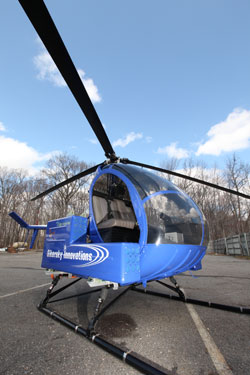
It is a dual-rotor, counterrotating system that needs no tail rotor—just a rear fin. A push bar allowed the pilot to change the direction of flight.
Sikorsky Innovations was prepared in 2011 to fly a two-seat S-300 at its research center in Florida. The S300 was known as a Hughes and then Schweizer 300 before Sikorsky took it over. Those plans were delayed by higher priorities, like the S–76D and the S–97 Raider (a 220-knot dual-rotor helicopter). It was within six weeks of flying when the decision came to postpone the flight.
Known as the Firefly, Sikorsky’s electric demonstration helicopter may be the first off-the-shelf helicopter to be adapted for fully electric power. Once the flight occurs, and the company says it is “inching along very slowly,” it will then go back on the shelf to await future developments in battery technology.
Helicopters aren’t very kind to batteries. They drain power quickly for liftoff, sip it sparingly in cruise, but need another burst of electricity at the end of the flight to land. Today, there are no batteries that can do the job for a fully operational helicopter. Batteries are also heavy and limit payload.
Firefly features a number of innovations, including a 190-horsepower electric motor, lithium-ion cells with a new chemistry combination, an automated monitoring and alert system, and advanced flight controls. If routine electric helicopter flight can be achieved, it will also be a big step toward environmentally friendly flight.
There are already payoffs. The Sikorsky team has demonstrated a 300-percent increase in propulsion efficiency. An electric helicopter may not need traditional rotorcraft drive components, something that could reduce not only vibration but operating costs.
First flights will last only five to 10 minutes, when they occur: a small step to the future.

